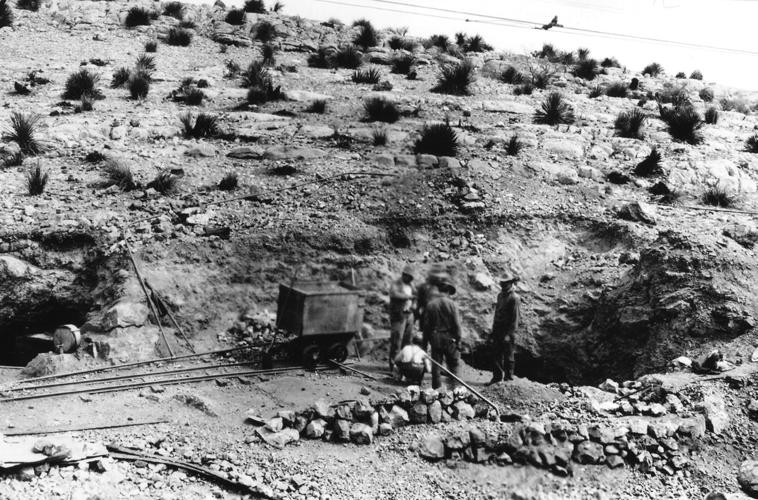Early manganese deposits discovered in Arizona included those in the Bisbee, Globe, Patagonia and Tombstone districts.
Found in concentrated deposits of loose fragments in multiple layers of rock, manganese was mined as part of gangue silver ore deposits and used as smelter flux.
Ferromanganese, from manganese ore containing 48 percent manganese combined with iron and carbon has been used in steel production such as in railroad tracks, bank vaults, tools and heavy duty equipment.
Manganese hardens steel, making it corrosion-resistant and shock proof. On average, 10 to 20 pounds of manganese added per ton of steel prevents its structure from shattering like glass.
Manganese has also been used in the manufacture of pig iron, lithium-ion batteries for electric and hybrid cars, disinfectants, coloring agents in cloth, dyes, glass, fertilizer, paints and pottery.
There is no substitute metal for its applications.
Several ores of manganese include pyrolusite, which has been used to add and remove coloration in glass. Others include manganite, psilomelelane and rhodochrosite.
Manganese is a steel-gray, shiny, hard and brittle metal with a melting point of 2,275 degrees Fahrenheit.
Found as combinations with other elements and forming part of the composition of more than 100 minerals, manganese does not occur as a native metal.
Commercial grade manganese ore is defined as materials containing more than 35 percent manganese composition. Pure manganese is acquired by heating manganese dioxide (MnO2) with carbon or aluminum, resulting in the removal of oxygen.
World War I saw an increase in manganese mining with Arizona at the forefront as a producer with deposits mined from limestone at Bisbee, including the Twilight, Atlas and Waterloo claims.
Manganese production in 1917 and 1918 in the Warren or Bisbee mining districts reached 32,000 tons, valued at $1 million.
Additional examples include the manganiferous ores of the Patagonia Mountains that were mined at the Black Eagle, Hardshell, Hermosa, and Mowry mines. The Hardshell Mine shipped 500 tons of manganese ore averaging above 40 percent manganese content during World War I. Historically, the manganiferous ores of the Tombstone District yielded less than commercial-grade quality of manganese.
Manganiferous veins were discovered in the California and Mineral Farm Groups around Globe, with a small quantity used as flux for the Old Dominion smelter.
The state’s best manganese deposits are located in the southern portion of Mohave County between the Williams River and the Artillery Mountains.
Between 1928 and 1955, Mohave County produced manganese from underground and open-pit mining operations, enhancing the nation’s strategic reserve and its thriving steel industry.
Wenden, in Western Arizona’s La Paz County, served as a government stockpile for manganese from outlying mining districts, including the Artillery Mountains during World War II and into the 1950s.
The U.S. Defense Department classified manganese as a strategic metal because of its importance to the steel and aluminum industries. That resulted in the implementation of a government buying program.
Domestic manganese mining ceased in 1970. The United States presently lacks manganese reserves, and relies solely on manganese ore imported from Australia, Gabon and South Africa. It costs more than $1 billion annually.
Global demand for manganese continues to grow as China and other developing economies industrialize.
Arizona is credited with having historically produced a quarter-billion pounds of manganese.
Current Arizona manganese exploration involves the American Manganese Co. and its extensive drilling and metallurgical testing program over a 12-square-mile area of past producing mines in the Artillery Peak District. A 2009 study reported about 1 billion pounds of “indicated” contained manganese and 9.6 billion pounds of “inferred” contained manganese.
AZ Mining Inc. formerly Wildcat Silver Corp. is currently involved in the Hermosa Central, a silver-manganese manto oxide development project in the Patagonia Mountains expected to yield 7.2 billion pounds of manganese.
As of 2015, domestic consumption of manganese in the United States has been estimated at $950 million annually.





